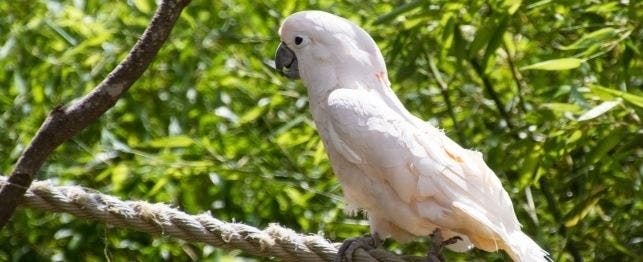
Choosing a Moluccan Cockatoo
Moluccan cockatoos are highly intelligent birds that make excellent pets: Charming and affectionate, they love to cuddle. The problem with all this devotion is that they demand attention back – big time. And, if they don’t get it, they can turn destructive and annoyingly noisy. Some become possessive of their owners and aggressive toward other people; others turn to plucking or self-mutilation.
Moluccans (Cacatua moluccensis) are not known for an ability to mimic, but that doesn’t mean they’re quiet. On the contrary – they’re quite vocal, with a habit of loud screaming. They often pick this up as babies that copy morning or afternoon screaming of other cockatoos.
Another problem – particularly with males – is aggression toward their mates. Fatal attacks may occur in which the male bird severely bites the face, wings and legs of the female. To help keep the female safe, have his wings clipped prior to breeding season.
Also known as salmon crested cockatoo, Moluccans are found on the Indonesian islands of Seram, Ambon and adjacent islands in Maluku province. In the wild, the birds, whose Latin name is Cacatua moluccensis, inhabit lowland forests, especially mature canopy forests along rivers. They are most active in early morning and late afternoon, feeding on nuts, young coconuts, seeds, berries, fruits and insects.
The birds can be very long lived: In zoos, some have survived up to 60 years. However, most birds die of disease or injury long before they reach that age.
Appearance
Moluccans are large pinkish-white cockatoos, whose salmon-colored crest feathers conform to the shape of the head, lying down unless the crest is raised. The body color ranges from pale pinkish white to pinkish salmon color. The birds range in length from 18 to 22 inches, with males usually larger than females.
Housing
Moluccans are very active and should be provided the largest cage that space and budget allow. Make sure the cage is solidly constructed, as these birds are strong chewers and can easily break welds on poorly constructed cages. Many are also adept at opening cage latches, so locks or escape-proof latches may be necessary. Ideally, a Moluccan cockatoo will also have an outdoor cage to allow playtime in the fresh-air and sunlight. In southern states, outdoor caging must be protected from opossums to prevent exposure to the parasite Sarcocystis falcatula, which can result in a fatal lung infection.
Since Moluccan cockatoos love to chew, they should be provided with toys, blocks of wood or branches. For their own safety, pet cockatoos should not be allowed to fly unsupervised in the house. Young cockatoos should be socialized to new people and situations early on.
Feeding
Cockatoos should be fed a formulated (pelleted or extruded) diet. The diet should be supplemented with fresh fruits and vegetables (mostly vegetables) daily. If the bird eats all of its food, give more, but remember that overfeeding these animals can lead to pickiness and wastage. Treats such as seeds, nuts and table foods may be given in small amounts especially as rewards for good behavior.
If overfed, Moluccan cockatoos may become obese. Young cockatoos are notoriously picky eaters and don’t seem to need much food to maintain themselves. Try to ensure that the food they do eat is nutritious, but vitamin supplements are not needed for birds on a formulated diet.
Grooming
Routine bathing or showering is vital for good plumage and skin condition. Birds can be misted and allowed to dry in a warm room or in the sun or gently dried with a blow drier. Don’t clip wing feathers excessively as cockatoos often fall and injure themselves; clip primary flight feathers only enough so the bird will glide to the floor.
Breeding
Moluccan cockatoos breed well in captivity. In North America, the predominant breeding season is winter and spring, although some pairs may produce year round. Breeding age can be as young as three years, but hand-reared birds may not begin breeding before they are eight to 10 years old, especially hand-fed males. The breeding life span is not precisely known but is possibly up to 30-plus years.
Incubation period is approximately 24 to 26 days, with a clutch size of one to three eggs. The chicks usually fledge at 12 to 14 weeks. When breeding cockatoos, noise and proximity to neighbors must be considered. If housed outdoors, cockatoos often call at night especially during a full moon.
Common Diseases and Disorders
Cockatoos are relatively healthy birds but are susceptible to the following:
- Psittacine Beak and Feather Disease
- Feather-picking
- Psittacosis
- Mate aggression
- Self mutilation
- Juvenile chewing of flight feathers and tail
- Poor eating habits – picky eaters
- Obesity, fatty liver disease (baby birds that are overfed)
- Bacterial and fungal infections
- Sarcocystis
- Cloacal prolapse
- Toxicity, ingestion of metals